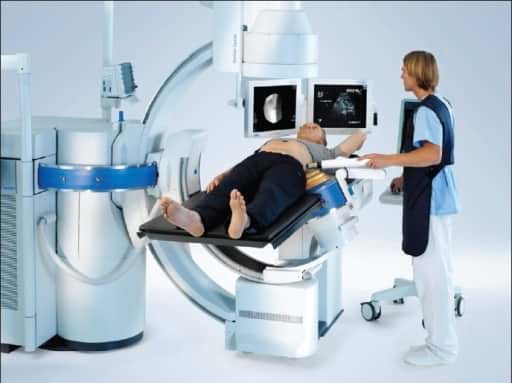What does the procedure involve?
Lithotripsy is a non-invasive procedure for treating kidney stones. Shockwaves are sent through the skin, and focused onto kidney stone(s) to break them up into small enough fragments to pass naturally. The stone(s) are localized with x- ray or ultrasound.
What are the alternatives to this procedure?
Alternatives to this procedure include telescopic surgery, open surgery and observation to allow stones to pass on their own.
What should I expect before the procedure?
You will usually be admitted to hospital on the same day as your surgery. You should bring all x-rays and scans of your kidneys that show your stone(s).
You will be asked not to eat and drink for six hours before surgery. Immediately before the operation, the anaesthetist may give you a pre-medication, which will make you dry-mouthed and pleasantly sleepy.
Please tell your surgeon (before your surgery) if you have any of the following:
- An artificial heart valve.
- A coronary artery stent.
- A heart pacemaker or defibrillator.
- An artificial joint.
- An artificial blood-vessel graft.
- A neurosurgical shunt.
- Any other implanted foreign body.
- A regular prescription for anticoagulant such as warfarin, aspirin or clopidogrel (Plavix®), Brilinta, Xarelto, Pradaxa etc.
- A previous or current infection with a multi-antibiotic resistant bug such as MRSA, VRE, ESBL.
What happens during the procedure?

Normally, lithotripsy is performed under a general anesthetic. It can also be performed under sedation. After localising the stone with x-ray or ultrasound, the lithotripsy machine is used to generate and deliver shock waves through the skin to break up the stone(s). Your treatment will normally last between 30 and 60 minutes, depending on the size, number and hardness of your stones.
What happens immediately after the procedure?
As soon as you have recovered from your anesthetic, you will be able to go home. You must bring someone with you to escort you home and you should not attempt to drive yourself after having an anaesthetic. You will be given antibiotics and painkillers to take at home and the average hospital stay is less than one day.
Are there any side-effects?
Most procedures are straightforward. Although the complications listed below are well recognized, most patients do not suffer any problems.
Common (greater than 1 in 10)
- Blood in your urine for a short time after the procedure.
- Pain in your kidney as small fragments of stone pass (20%).
- Urinary infection due to bacteria released as the stone breaks (10%).
- Bruising or blistering of the skin.
- Need for further lithotripsy treatment (15 to 20%).
- Failure to break very hard stone(s), which may need alternative treatment (20%).
Occasional (between 1 in 10 and 1 in 50)
- Severe infection requiring intravenous antibiotics (less than 1%) and drainage of the kidney by a small tube placed into the kidney.
- Stone fragments may get stuck in the tube between the kidney and the bladder; this may require surgery to remove the fragments.
Rare (less than 1 in 50)
- Kidney damage (bruising) or infection needing further treatment.
What should I expect when I get home?
When you get home, you should drink twice as much fluid as you would normally. This helps to flush your system through and minimises any bleeding or infection. You may take painkillers when necessary and you must complete the prescribed course of antibiotics.
You may see blood in the urine for 48 to 72 hours. If you develop bruising or blistering on your skin, you can apply simple skin creams to ease any discomfort. This bruising normally disappears within seven days.
What else should I look out for?
Small blood clots or stone fragments can pass down from the kidney, resulting in renal colic. If you develop a fever, severe pain on passing urine, you cannot pass urine or your bleeding increases, you should contact your Urologist or GP immediately - out-of-hours you may need to attend the emergency department.
Are there any other important points?
You will be informed about any follow-up arrangements before you go home. This may involve further lithotripsy, surgery or an appointment for a further X-ray.
If you have a ureteric stent in place, this will need to be removed by your urologist within a few weeks as you can form new stones on the stent – make sure you find out from your urologist when your stent will be removed or exchanged.
You can reduce the risk of further stones by changing your diet and increasing your fluid intake. If you have not already received a leaflet about this, contact your specialist nurse or your consultant.
Disclaimer
This information is intended as a general educational guide and may not apply to your situation. You must not rely on this information as an alternative to consultation with your urologist or other health professional.
Not all potential complications are listed, and you must talk to your urologist about the complications specific to your situation.
